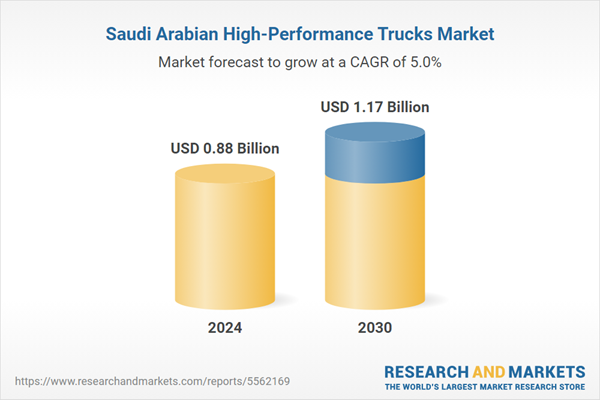Speak directly to the analyst to clarify any post sales queries you may have.
10% Free customizationThis report comes with 10% free customization, enabling you to add data that meets your specific business needs.
Set to start production in Q4 2026 with a 50,000-vehicle annual capacity, the facility will manufacture both internal combustion and electric vehicles. This project supports Vision 2030 goals by boosting local automotive production, generating skilled jobs, and promoting technological growth. These trucks, known for their superior engine capabilities, torque output, and durability under extreme conditions, are gaining traction in construction, mining, and long-haul transportation sectors. High-horsepower engines, robust suspension systems, and enhanced payload capacities make these vehicles essential for applications requiring continuous performance under demanding conditions. Industries are prioritizing reliable, powerful transport options to meet operational timelines, creating strong demand for high-performance trucks. Original equipment manufacturers are responding with advanced models that integrate power, technology, and fuel efficiency to align with evolving industrial needs.
Market Drivers
Expansion of Industrial and Mining Operations
High-performance trucks are essential in industrial and mining environments due to their durability, load capacity, and ability to operate under intense conditions. The growing need for hauling raw materials and equipment in mining zones, construction sites, and industrial corridors increases the reliance on trucks that deliver consistent performance without frequent maintenance. Their enhanced suspension, reinforced chassis, and power-dense engines allow them to navigate rugged terrains and carry heavy payloads, which standard trucks cannot handle effectively.Industries require transport solutions that can sustain long hours without failure, making high-performance trucks a preferred choice. The trend towards automating and mechanizing material transport processes further reinforces this demand, as these trucks integrate more advanced telematics and load-management systems. The ability to operate efficiently under extreme temperatures and conditions adds to their appeal in harsh industrial environments. As resource extraction and heavy manufacturing continue to expand, demand for high-performance transport solutions will scale in parallel, making this a central driver of market growth.
Key Market Challenges
High Initial Acquisition Costs
High-performance trucks come with significant upfront investment due to their advanced engineering, premium components, and built-in smart systems. These trucks often include reinforced chassis, high-capacity engines, automated transmissions, and digital control units that raise their price considerably compared to standard commercial trucks. This cost poses a barrier to adoption for small and medium fleet operators who typically operate within constrained budgets. Although these trucks offer long-term cost benefits through reduced maintenance and better fuel economy, the heavy capital outlay can limit accessibility.Leasing or financing options are not always favorable, particularly for smaller businesses or new entrants in the logistics sector. Moreover, buyers often face higher insurance premiums due to the elevated vehicle value and potential repair costs. These financial challenges can slow down fleet modernization efforts, especially in cost-sensitive segments of the transport industry. High-performance trucks thus remain concentrated among large logistics players, limiting their broader market penetration.
Key Market Trends
Integration of Predictive Maintenance Systems
High-performance trucks are increasingly being equipped with predictive maintenance technologies that use real-time data analytics to forecast potential mechanical failures. These systems monitor engine health, brake performance, tire pressure, and fluid levels through embedded sensors and IoT-based communication. By analyzing performance trends and triggering alerts for necessary repairs before breakdowns occur, fleet operators can minimize downtime and reduce unexpected costs.Predictive maintenance not only extends the truck's life cycle but also ensures more efficient scheduling of service intervals. These systems provide insights into usage patterns and wear-and-tear cycles, helping in parts inventory management and operational planning. The shift from reactive to predictive maintenance is transforming fleet management strategies, promoting cost efficiency and operational continuity. As data becomes central to asset utilization, trucks with such capabilities are becoming more attractive to logistics companies focused on minimizing risk and increasing uptime.
Key Market Players
- Mercedes-Benz Group AG
- AB Volvo
- Tesla, Inc.
- Volkswagen AG
- Ford Motor Company
- Stellantis N.V.
- General Motors LLC
- Toyota Motor Corporation
- Rivian, LLC
- PACCAR Inc
Report Scope:
In this report, the Saudi Arabia High-Performance Trucks Market has been segmented into the following categories, in addition to the industry trends which have also been detailed below:Saudi Arabia High-Performance Trucks Market, By Vehicle Type:
- Conventional Pickup Trucks
- Crew-cab
- Sport Trucks
Saudi Arabia High-Performance Trucks Market, By Propulsion Type:
- IC Engine
- Hybrid & Electric
Saudi Arabia High-Performance Trucks Market, By Transmission Type:
- Automatic
- Automatic Manual Transmission (AMT)
- Manual
Saudi Arabia High-Performance Trucks Market, By Region:
- Northern & Central
- Southern
- Eastern
- Western
Competitive Landscape
Company Profiles: Detailed analysis of the major companies present in the Saudi Arabia High-Performance Trucks Market.Available Customizations:
With the given market data, the publisher offers customizations according to the company’s specific needs. The following customization options are available for the report.Company Information
- Detailed analysis and profiling of additional market players (up to five).
This product will be delivered within 1-3 business days.
Table of Contents
Companies Mentioned
- Mercedes-Benz Group AG
- AB Volvo
- Tesla, Inc.
- Volkswagen AG
- Ford Motor Company
- Stellantis N.V.
- General Motors LLC
- Toyota Motor Corporation
- Rivian, LLC
- PACCAR Inc
Table Information
| Report Attribute | Details |
|---|---|
| No. of Pages | 85 |
| Published | July 2025 |
| Forecast Period | 2024 - 2030 |
| Estimated Market Value ( USD | $ 0.88 Billion |
| Forecasted Market Value ( USD | $ 1.17 Billion |
| Compound Annual Growth Rate | 5.0% |
| Regions Covered | Saudi Arabia |
| No. of Companies Mentioned | 10 |









